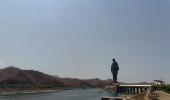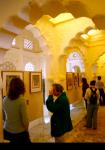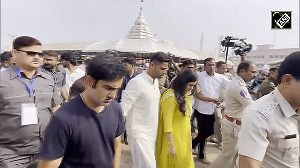Whether it's navigating the labyrinthine Cu Chi Tunnels, boating on the Mekong, marveling at ancient Champa temples, or the Mekong Bay, Vietnam promises a journey like no other.

I have always been intrigued by this country of 100 million people spread over just 128,000 square miles.
A country which gave a bloody nose to the Americans and threw out the French.
In just about 50 years after it secured its real independence, Vietnam has risen from poverty, famine and destruction to become one of the prosperous nations in that part of the world.
Having read and studied the Vietnam War while being in the forces, we -- my veteran friend and I -- were keen to visit this country to experience the remnants of history as well as the natural beauty that Vietnam had on offer.
We flew the 3,500 odd kilometers across the seas to explore Vietnam. It was a 10-night-11-day trip starting in the south in Ho Chi Minh City and ending in the north in the capital Hanoi.
During our travels, it was evident that Vietnam and the Vietnamese people had put in a lot of effort in making their country tourist friendly and affordable.
The tourist infrastructure is well developed and easily accessible.
We generally sensed that the tourists were happy as they consumed Vietnam, barring an Indian family who had a bad experience while staying at a homestay.
This trip was planned from home, making use of the Internet; and as it unfolded, there were a lot of things to learn.
As I take you through our Vietnamese experience, I shall flag some points that need to be kept in mind for tourists who have Vietnam on their radar. So here goes...
Planning Your Trip
Flights
We flew with VietJet, which offers affordable flights from major Indian cities.
Be prepared for delays and a no-frills experience; even water isn't complimentary!
Our total airfare, including internal travel, was around Rs 39,000.
Booking Tours
Major excursions were booked online in advance, but we noticed that last-minute bookings through local agencies often offered similar prices.
Bargaining at tourist offices which abound every marketplace could also yield good deals.
However, do your homework online before finalising anything.
In case planning last minute, it would be a good idea to ask local guides and tourists who have been there and done that.
Visa
The e-visa process is straightforward and costs $25. Avoid agents charging double.
Apply online; it takes at least three or four days for the embassy to issue the e-visa.
Get into bookings only after you obtain your visa.
Money Matters
The Vietnamese dong (VND) is around 300 to a rupee, making purchases feel surreal with prices running into lakhs.
Stick to the local currency for better value although the shops are more than happy to be paid in dollars/euros.
When you shop around, avoid asking prices unless you are serious about buying -- the vendors can turn very persistent and follow you through the market if you casually ask for cost!
For a couple, $500 should suffice for 10 days, covering food, fun, and shopping.
The total cost of our trip was under one lakh rupees per head, all inclusive. (Shopping too!)
Packing Essentials
- Clothing: Light, quick-dry outfits and sturdy sandals are ideal.
Pack a sun hat and waterproof raincoat for unexpected showers.
Take a pair of trekking/walking shoes too. - Food: Carry snacks if your palate leans Indian, as local food might feel bland. We carried lots which turned out to be a blessing.
The adventurous could try the local cuisine but there are Indian restaurants at every corner to go to once your stomach growls for home food. - Miscellaneous: Essentials include a reusable water bottle, sunscreen, tissues, and swimwear.
A backpack can be handy to carry essentials during day trips.
Also take cotton hand/bath towels-should you decide on a dip in the ocean. - Water: Purchase 5-litre cans from supermarkets to save on drinking water costs.
Water could become an irritable experience if you do not plan well.

Journey Highlights
Ho Chi Minh City
- Cu Chi Tunnels: An extensive underground network used by the Viet Cong during the war.
The tour offers a haunting glimpse into the lives of soldiers who spent weeks in these cramped quarters.
Try to travel through one of the tunnels for an experience never to be forgotten (Not for the claustrophobic!) - Mekong Delta: A day trip here barely scratches the surface of this lush region, home to floating markets, palm groves, and homemade coconut candy.
Consider staying overnight for a deeper experience. - War Remnants Museum: A must-visit to understand the devastating impact of the Vietnam War.
The exhibits and captured American military hardware left us with misty eyes. - Keep half a day or so to walk around the city getting a feel of the culture and people of this southern city.


The temples, mostly dedicated to Lord Shiva, are partly in ruins but still reveal the Champa people's unique culture and architecture.
Da Nang
Da Nang is quaint and quiet with excellent views of the ocean; a place I would like to visit again and again.
The town is located along a road that curls along the coast for miles; and this is where one can find hotels and eateries of all kinds.
Sine this place mostly caters to tourists, Da Nang can be expensive, although we found that the tour packages were quite like the ones we experienced in Ho Chi Minh City.
- Son Tra Mountain: Known as Monkey Mountain, this spot offers a panoramic view of the city and its coast, along with an iconic Lady Buddha statue.
Listen to the intriguing history from your guide to understand the 'Indian' influence in the region. - Marble Mountains: A mix of nature, history, and spirituality, with caves, pagodas, and ancient sculptures.
While the climb may be challenging, the views and ambience are worth it.
A visit to the marble factory gives you glimpses of the excellent sculpture of this region. - My Son Sanctuary: The UNESCO World Heritage site showcases ancient Hindu temples dedicated to Lord Shiva.
The ruins, enveloped in mist and greenery, exude a mystical charm.
Learn how Hinduism and culture once thrived in this region.
Hanoi and Beyond
Though Hanoi was our last stop, we found its bustling streets, colonial architecture, and vibrant markets a fitting finale to our adventure.
The city, not surprisingly, is costly to live in. The hotel was sub-standard, but then, there was no time to crib since we had planned an outing to Nin-Binh early morning after our late night arrival.
- Nin Binh boasts of Southeast Asia's most beautiful, majestic and impressive natural scenery.
Walking through the paddy fields, cycling along beaten tracks through them and boating through the massive lake are recommended.
Depending on time available and your inclination, you can visit historical sites, temples, nature parks and wildlife reserves.
Mua caves, Hoa Lu, Trang An are particularly recommended. - The Old Quarter of Hanoi experience is like visiting a French town.
It is a lovely walk to savour the bakery products and watch tourists and locals having fun and frolicon the cobbled traffic free streets. - The city has lots on offer-coffee shops, trinket shopping, cheap clothing and more.
Just walk around or take a ride with ever willing (sometimes pestering!) scooter taxis or walking tours to taste the local cuisine and get a feel of this bustling city.
Try the beaten egg or yoghurt coffee -- it is worth it! - Halong Bay Tour: A long and interesting 170 km drive from Hanoi takes you to the majestic blue waters of Halong Bay.
The boat station here is much like a train or bus station bustling with tourists with boats of various sizes bobbing in the water waiting to take you down for an unforgettable ride.
The boat will take you to many small islands on the way and give you a lunch and snack on board (which I didn't quite like!).
One can get very tired with the long day at sea and has to endure the long bus ride to your hotel.
One could also plan to stay a couple of nights in the boats anchored in the bay for a different experience. - A word of advice: If going kayaking or a speed boat ride/any other water sport, make sure you do not carry your valuables and mobile phone on you...we were witness to some of our co-passengers taking an unintended dip, losing their most important communication equipment.
Final Thoughts
Vietnam is a land of contrasts, steeped in history yet rapidly modernising just as our own India.
Its people's resilience and warmth shine through, making every moment memorable.
Whether it's navigating the labyrinthine Cu Chi Tunnels, boating on the Mekong, marveling at ancient Champa temples, or the Mekong Bay, Vietnam promises a journey like no other.
So, pack light, stay curious, and let Vietnam captivate your heart as it did ours!
Some pointers to be kept in mind:
- Tour operators are strict about pick-up times. Please be ready in time if you do not want to miss the excursion.
- The local trips could be done in small cars which can turn out expensive. Buses are comfortable (25 seaters) and recommended.
Take a shawl/cover along for the bus travel since the air conditioning can get very cold. - Walks and climbs need to be planned for. Be kitted for them and keep your fitness in mind for the same.
- Must go deeper into the offered itinerary(s) and do deep research before taking decisions on where to go and what to do. It would be good to ask other tourists about their experience.
- Beware of photographers who follow you everywhere and click candid photos, only to sell them to you later.
- The passport and important documents are best left in the safe in the hotel room; no one asks you for them during internal travel.
- The Google translator comes in handy if you need to communicate with locals.
- Buy a local sim after landing at the airport and download the 'Grab' taxi app.
You can also order food using this application. - The guides/drivers expect tips at the end of the journey. Be prepared to leave some money for them.
- If you feel like a drink, you can buy beer at roadside shops unless you want to pay many times the cost at the eateries.
Eateries generally have chairs placed on the footpath at their entrance where one can enjoy a chilled drink or eat a meal.
My ratings for Vietnam: Food: 3/5. Places of tourist interest: 4/5. Budget hotels: 3.5/5. Value for money: 4.5/5. People: 5/5. Overall: 4.5/5.
Worth a visit.
A visual tour of Ho Chi Minh City and Danag
Ho Chi Minh City

















Danag



Videos
Feature Presentation: Ashish Narsale/Rediff.com











